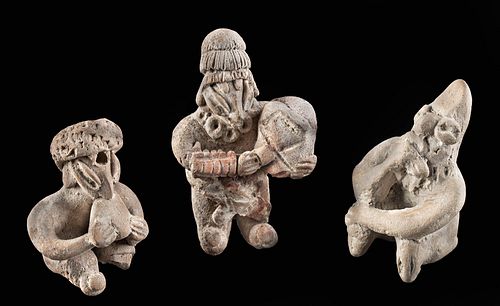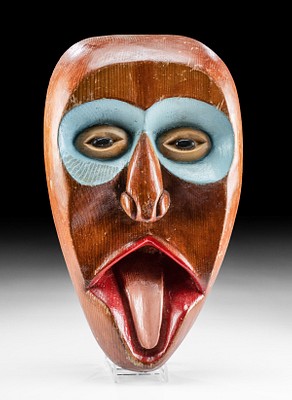Three Miniature West Mexican Pottery Figures
Lot 124
About Seller
Artemis Gallery
686 S Taylor Ave, Ste 106
Louisville, CO 80027
United States
Selling antiquities, ancient and ethnographic art online since 1993, Artemis Gallery specializes in Classical Antiquities (Egyptian, Greek, Roman, Near Eastern), Asian, Pre-Columbian, African / Tribal / Oceanographic art. Our extensive inventory includes pottery, stone, metal, wood, glass and textil...Read more
Categories
Estimate:
$300 - $450
Absentee vs Live bid
Two ways to bid:
- Leave a max absentee bid and the platform will bid on your behalf up to your maximum bid during the live auction.
- Bid live during the auction and your bids will be submitted real-time to the auctioneer.
Bid Increments
| Price | Bid Increment |
|---|---|
| $0 | $25 |
| $300 | $50 |
| $1,000 | $100 |
| $2,000 | $250 |
| $5,000 | $500 |
| $10,000 | $1,000 |
| $20,000 | $2,500 |
| $50,000 | $5,000 |
| $100,000 | $10,000 |
| $200,000 | $20,000 |
About Auction
By Artemis Gallery
Sep 9, 2021
Set Reminder
2021-09-09 10:00:00
2021-09-09 10:00:00
America/New_York
Bidsquare
Bidsquare : Art & Artifacts of North America
https://www.bidsquare.com/auctions/artemis-gallery/art-artifacts-of-north-america-7436
Join us for a special auction not to be missed! Collectible Native American art from antiquity to mid-20th century, Spanish Colonial, Latin American, fine & folk art, American frontier items, and much more! Artemis Gallery info@artemisgallery.com
Join us for a special auction not to be missed! Collectible Native American art from antiquity to mid-20th century, Spanish Colonial, Latin American, fine & folk art, American frontier items, and much more! Artemis Gallery info@artemisgallery.com
- Lot Description
Pre-Columbian, West Mexico, Chupicuaro and Colima, ca. 500 BCE to 300 CE. An attractive trio of hand-built pottery miniatures in varying forms and poses. The figurine that is seen seated with a noticeably pointed head is of Colima origin, while the other two hail from more inland in neighboring Chupicuaro. Both styles are quite distinct from each other, helping illustrate the subtle differences in aesthetics between the two neighboring societies. The idols from Chupicuaro are both decorated with elaborate headwear, each carrying cumbersome loafs of bread in hand. Their faces are incised with elongated and angled ovoid-form eyes, with thin spear-shaped noses. The one seen standing is adorned with a variety of accessories including a necklace with multiple hoops and a frayed arm sleeve. The figure from Colima is depicted playing an ocarina looking through inquisitive eyes over a bulbous nose – it his hunched forward with adjacent arm balancing itself over his right knee as if playing in front of a campfire. Size: 1.25" W x 1.75" H (3.2 cm x 4.4 cm)
Provenance: private Fayetteville, Arkansas, USA collection; ex-Dr. David Harner collection, Springdale, Arkansas, USA, acquired between the 1950s and 1960s
All items legal to buy/sell under U.S. Statute covering cultural patrimony Code 2600, CHAPTER 14, and are guaranteed to be as described or your money back.
A Certificate of Authenticity will accompany all winning bids.
PLEASE NOTE: Due to recent increases of shipments being seized by Australian & German customs (even for items with pre-UNESCO provenance), we will no longer ship most antiquities and ancient Chinese art to Australia & Germany. For categories of items that are acceptable to ship to Australia or Germany, please contact us directly or work with your local customs brokerage firm.
Display stands not described as included/custom in the item description are for photography purposes only and will not be included with the item upon shipping.
#163570One of the figures is missing a small portion of its right foot. Otherwise, this collection is fully intact and in excellent condition - with original pigments used still visible throughout the figures' surfaces.Condition
- Shipping Info
-
All shipping is handled in-house for your convenience. Your invoice from Artemis Gallery will include shipping calculation instructions. If in doubt, please inquire BEFORE bidding for estimated shipping costs for individual items.
-
- Buyer's Premium



 EUR
EUR CAD
CAD AUD
AUD GBP
GBP MXN
MXN HKD
HKD CNY
CNY MYR
MYR SEK
SEK SGD
SGD CHF
CHF THB
THB













